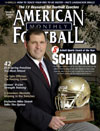AMERICAN FOOTBALL MONTHLY THE #1 RESOURCE FOR FOOTBALL COACHES
Article CategoriesAFM Magazine
|
On Solid Ground: Conditioning Your Athleteby: Gregory “Graig\\© More from this issue When it comes to creating an athlete who can withstand the rigors of competing, there is an awful lot that goes into it. While being in the business since 1990 I have come to identify what I consider to be the 4 most important steps in getting this done. When done properly, the results can not be denied. The Event (Step 1) When conditioning for an event, many factors must be considered. The requirements can vary dramatically from sport to sport. Some of the things that must be thought about are what demands are made on the body, anaerobic, aerobic or both? Which muscles will be stressed? Which are the most common injuries? And the most important question is the conditioning protocol as efficient and effective as it can be? I hope that more coaches will take a closer look at their sports and get ....The full article can only be seen by subscribers. Subscribe today!
|
|
|||||||
| HOME |
MAGAZINE |
SUBSCRIBE | ONLINE COLUMNISTS | COACHING VIDEOS |
Copyright 2025, AmericanFootballMonthly.com
All Rights Reserved





